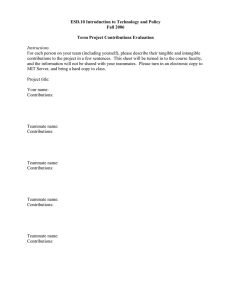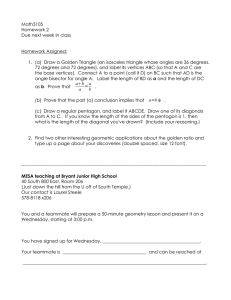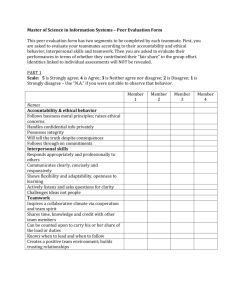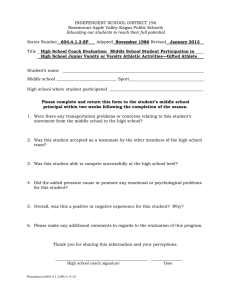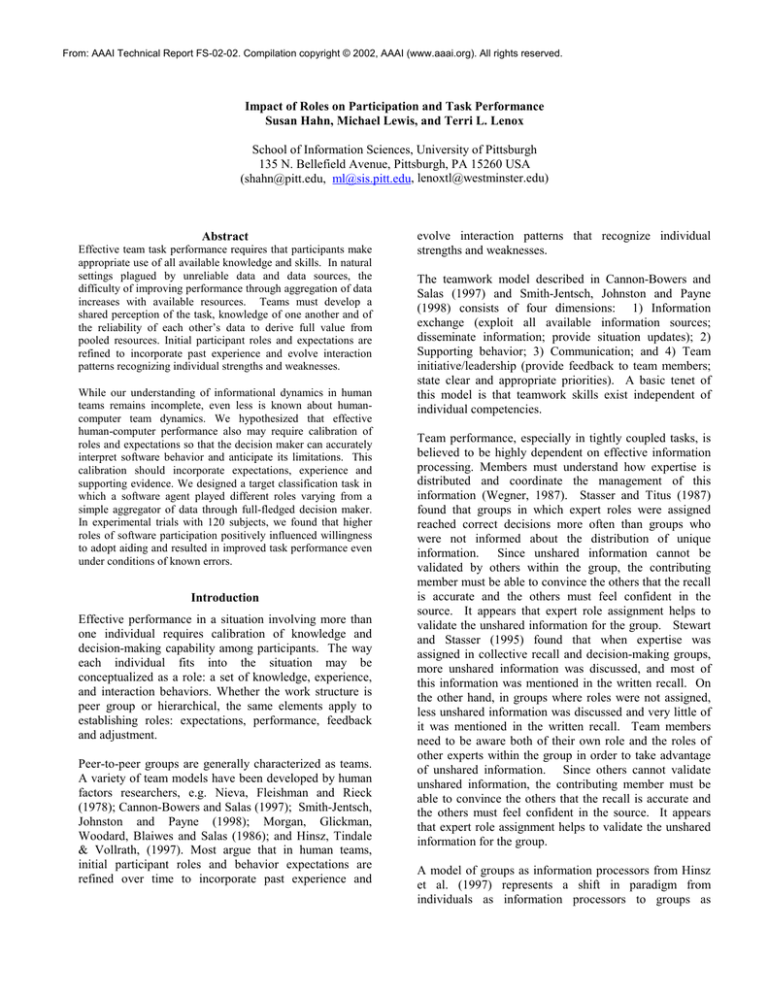
From: AAAI Technical Report FS-02-02. Compilation copyright © 2002, AAAI (www.aaai.org). All rights reserved.
Impact of Roles on Participation and Task Performance
Susan Hahn, Michael Lewis, and Terri L. Lenox
School of Information Sciences, University of Pittsburgh
135 N. Bellefield Avenue, Pittsburgh, PA 15260 USA
(shahn@pitt.edu, ml@sis.pitt.edu, lenoxtl@westminster.edu)
Abstract
Effective team task performance requires that participants make
appropriate use of all available knowledge and skills. In natural
settings plagued by unreliable data and data sources, the
difficulty of improving performance through aggregation of data
increases with available resources. Teams must develop a
shared perception of the task, knowledge of one another and of
the reliability of each other’s data to derive full value from
pooled resources. Initial participant roles and expectations are
refined to incorporate past experience and evolve interaction
patterns recognizing individual strengths and weaknesses.
While our understanding of informational dynamics in human
teams remains incomplete, even less is known about humancomputer team dynamics. We hypothesized that effective
human-computer performance also may require calibration of
roles and expectations so that the decision maker can accurately
interpret software behavior and anticipate its limitations. This
calibration should incorporate expectations, experience and
supporting evidence. We designed a target classification task in
which a software agent played different roles varying from a
simple aggregator of data through full-fledged decision maker.
In experimental trials with 120 subjects, we found that higher
roles of software participation positively influenced willingness
to adopt aiding and resulted in improved task performance even
under conditions of known errors.
Introduction
Effective performance in a situation involving more than
one individual requires calibration of knowledge and
decision-making capability among participants. The way
each individual fits into the situation may be
conceptualized as a role: a set of knowledge, experience,
and interaction behaviors. Whether the work structure is
peer group or hierarchical, the same elements apply to
establishing roles: expectations, performance, feedback
and adjustment.
Peer-to-peer groups are generally characterized as teams.
A variety of team models have been developed by human
factors researchers, e.g. Nieva, Fleishman and Rieck
(1978); Cannon-Bowers and Salas (1997); Smith-Jentsch,
Johnston and Payne (1998); Morgan, Glickman,
Woodard, Blaiwes and Salas (1986); and Hinsz, Tindale
& Vollrath, (1997). Most argue that in human teams,
initial participant roles and behavior expectations are
refined over time to incorporate past experience and
evolve interaction patterns that recognize individual
strengths and weaknesses.
The teamwork model described in Cannon-Bowers and
Salas (1997) and Smith-Jentsch, Johnston and Payne
(1998) consists of four dimensions: 1) Information
exchange (exploit all available information sources;
disseminate information; provide situation updates); 2)
Supporting behavior; 3) Communication; and 4) Team
initiative/leadership (provide feedback to team members;
state clear and appropriate priorities). A basic tenet of
this model is that teamwork skills exist independent of
individual competencies.
Team performance, especially in tightly coupled tasks, is
believed to be highly dependent on effective information
processing. Members must understand how expertise is
distributed and coordinate the management of this
information (Wegner, 1987). Stasser and Titus (1987)
found that groups in which expert roles were assigned
reached correct decisions more often than groups who
were not informed about the distribution of unique
information. Since unshared information cannot be
validated by others within the group, the contributing
member must be able to convince the others that the recall
is accurate and the others must feel confident in the
source. It appears that expert role assignment helps to
validate the unshared information for the group. Stewart
and Stasser (1995) found that when expertise was
assigned in collective recall and decision-making groups,
more unshared information was discussed, and most of
this information was mentioned in the written recall. On
the other hand, in groups where roles were not assigned,
less unshared information was discussed and very little of
it was mentioned in the written recall. Team members
need to be aware both of their own role and the roles of
other experts within the group in order to take advantage
of unshared information. Since others cannot validate
unshared information, the contributing member must be
able to convince the others that the recall is accurate and
the others must feel confident in the source. It appears
that expert role assignment helps to validate the unshared
information for the group.
A model of groups as information processors from Hinsz
et al. (1997) represents a shift in paradigm from
individuals as information processors to groups as
information processors. Groups process relevant and
available information to perform intellectual tasks. This
processing involves activities among the minds of group
members and within the group. At the group level
“information processing involves the degree to which
information, ideas, or cognitive processes are shared, and
are being shared, among the group members and how this
sharing of information affects both individual- and grouplevel outcomes “ (Hinsz, Tindale & Vollrath, 1997, pg.
43). Failure to appropriately use team member capabilities
may be caused by a mismatch of decision control and
relevant knowledge (Sarter and Woods, 1994).
In hierarchical structures, job positions and titles form the
basis for expectations regarding expertise, performance,
and participation in decision-making. In addition, both
supervisors and subordinates may exhibit individual
preferences for participation. Both type of task and
personal characteristics may interact to impact degree of
participation (Abel-Halim, 1983). As in peer groups, the
level of expertise among participants must be calibrated.
Performance may be judged by observing subordinate
behavior or measuring outcome results. If the supervisor
understands the behaviors necessary to succeed, and those
behaviors are observable, feedback and calibration can
occur at interim points during the task. In situations
where the supervisor does not have extensive task
knowledge, or the appropriate behavior is not observable,
performance will tend to be judged on outcomes achieved
(Ouchi, 1979). For complex tasks, supervisor knowledge
of the task appears to be a key determinant in selecting
outcome control (Kirsch, 1996). In that case, the
subordinate will participate more in making decisions
than in lower-level data processing.
Human-Computer calibration the software may not be
designed to explicitly assist in establishing capabilities
and calibrating expectations or have flexibility in
adaptation. We have conducted experiments that varied
the role (information access, categorization, or decision)
of software while holding the (potential) impact of the
information it provided constant.
Method
We modified a moderate fidelity simulation (Tandem) of
a radar target identification task, jointly developed at the
Naval Air Warfare Center - Training Systems Division
(Weaver, Morgan, and Hall, 1993) and the University of
Central Florida to investigate human-computer
interaction. During a simulation session sixty targets were
presented, distributed in several concentric rings on the
screen. The circle closest to the center is called the
“circle of fear” and targets there should receive highest
priority (Figure 1). Subjects ‘hooked’ a target by clicking
on it, selecting ‘hook’ from the menu. They could then
examine five parameters each to identify target type
(air/surface/submarine), source (civilian/military) and
intent (peaceful/hostile), and then decide on an
appropriate response. The task imposed a high workload
for information gathering and aggregation in a reactive,
time critical situation.
Figure 1 - - The Tandem Display
I SCORE : 1950
Time : 00:14:25
OPER
A
B
000
Scully, Kirkpatrick and Locke (1995) found that in
simulated supervisor/employee dyads higher task
performance resulted when: 1) the supervisor had correct
information and there was no participation from the
employee; or 2) the employee participated and neither
party had incorrect information or at least one party had
correct information. Similar problems may arise in
human-agent teams when a software agent has sole or
preferential access to needed information.
*
*
270
*
*
*
*
*
*
* *
* *
090
*
Circle of Fear
180
Appropriate use of information from others may depend
upon experience, to calibrate the quality of data (Muir,
1987). However, in situations where people don’t have
time or confidence in their own ability to complete a task,
they are likely to rely on computer recommendations
despite errors, because they believe that will lead to better
overall performance (Lee and Moray, 1992).
Human-Human calibration often involves explicit
discussion of expertise and information sources. In
TEAMM
ATE
Radius : 50 nm
Hooked Target : 35
C
We developed three roles for a software teammate, to
assist in accessing and processing data for the decision
task:
1.
2.
2.
LIST (aggregated information) – an assembled list of
parameters and values: climb/dive rate, speed, signal
strength, and communication time;
TABLE (inferential information) -- a table showing
parameter values classified by type in columns;
ORACLE (decision information) -- a message with
an associated certainty factor e.g., “target 101is with
.85 certainty a submarine”. The raw parameter
values remained available via an explanation button.
Subjects were required to use the menus alone for
decisions on target source and intent; the teammate could
be used to assist in classifying target type by accessing
and processing four of the five relevant parameters. They
were given a cue sheet for target type identification
parameters (Table 1) and the remaining two tasks.
Table 1: Target Type Identification Parameters
Current Speed
Initial
Altitude/Depth
Initial Climb/
Dive Rate
Signal Strength
Communication
Time
AIR
>35 knots
> 0 feet
SURFACE
25-35 knots
0 feet
SUB
<25 knots
< 0 feet
> 0 feet/m
0 feet/m
<0 feet/m
Medium
0-40 secs
High
41-80 secs
Low
81-120
secs
We also investigated effects of errors, which could occur
in any role. In the control case, all three roles for aiding
provided correct information so that data presented was
derived directly from the Tandem menus. In other
conditions errors were introduced in reading (data),
categorization (classification) or in designating type
(decision). Table 2 shows the agent roles and their
potential types of errors. Data errors occurred when data
displayed was different than data shown on the menus.
This type of error was explained to the subjects as
‘problems with the agent’s sensors’. Classification errors
occurred when data was placed into the wrong column in
the table. For decision errors, type and certainty were
assigned independent of the underlying parameters on
error trials. Classification and Decision errors were
explained to subjects as ‘software problems'. Only one
type of error was present for each subject, and the
presence of each type of error was equated. For example,
a decision-making teammate (Oracle) might commit data
errors, classification errors, or decision errors; but each
would support the same rate of erroneous decisions.
Table 2: Teammate Roles and Error Conditions
Errors
None
Data
Classification
Decision Rule
LIST
TABLE
ORACLE
X
X
X
X
X
X
X
X
X
For every target at least three of the data values agreed, to
permit correct type identification. Error detection became
increasingly difficult with greater roles of information
aggregation. Data errors required comparing presented
parameter values with those found on the menus.
Classification errors required comparison between
displayed category of a parameter and the proper
categorization of its value. Detecting decision errors
required performing the classification task manually and
comparing the result.
Subjects were trained on the Tandem software for 10
minutes, followed by three 15-minute trials. Each subject
saw one teammate role, with one of the four possible error
conditions (Table 1). There were no “surprises” for role
behavior or errors; actual teammate behavior in both
training and trials was consistent with expected behavior.
Subjects had free choice on the use of the teammate’s
information. They could request data processed by the
agent or get raw data directly by accessing menus.
Independent variables were teammate role (list, table,
oracle) and error condition. Dependent variables were
task performance and reliance on the software teammate.
Task performance was measured as: 1) number of targets
hooked; 2) correct identification of target type, source,
and intent; and 3) timeliness of target identification, i.e.
time spent in the "circle of fear". We also recorded button
presses to access the teammate or make menu selections,
and several time measures.
Goals and Rational Decision Making
The goal for subjects was to maximize performance by
getting information to correctly identify targets and either
shoot or clear them, working from the circle of fear
outward. Subjects could use the menus, the teammate, or
both. However, due to the high workload conditions,
subjects who relied on the menus alone would find it
difficult to perform effectively. In the no-error condition,
the decision to use a software teammate was a pure
participation decision. In error conditions, participation
should be modified by some verification of data. As
mentioned above, data verification strategies varied with
roles of data aggregation.
A minimum of 3 values will agree regardless of the error
condition.
Level of Aggregation
& Nature of Error
Level 1 (List
Error) - incorrect data
values.
Rational Decision Maker Strategy
(Minimum of 3 values will agree.)
If at least 3/4 values agree, assign type
classification based on values observed
compared to cue-sheet values
else (2/4) check fifth value from menu
and assign type classification based on
values observed compared to cue-sheet
values.
However, willingness to accept teammate participation
for decision making from Role 3 (Oracle) was highest
under all conditions (p < .03), despite the greater
difficulty of error detection.
More targets were engaged in conditions without errors
(see Figure 3).
Figure 3: Average Targets Hooked
14
13
Level 2 (Table
Error) -- incorrect
classification of data
values into table (i.e.,
right data, wrong
column).
Level 2 (Data
Error) – incorrect data
values.
Level 3 (Oracle
Error) – incorrect
conclusion drawn from
correct data values
If a comparison of aggregated data in
table <> expected classification on cuesheet, reclassify “misplaced” value into
the correct column.
See strategy for Level 1 error.
If confidence factor is greater than 70 %
assign classification, else check values
from table using the “see justification”
button.
Results
Performance was analyzed using a repeated measures
analysis of variance with session as the within subject
factor and with software role of participation and error
conditions as between group factors. Effects of session
were significant (p < .05) for each of the dependent
measures reported. Not surprisingly, subjects relied more
on Role 1 (List) and Role 2 (Table) software teammates in
the "no error" condition (p < .01). See Figure 2.
12
11
ERROR
10
None
9
Data
Classify
8
Assign
7
List
Table
Oracle
Both teammate role (p < .02) and error (p < .01) affected
performance in the type identification task (Figure 4).
Figure 4: Percent of Targets Correctly Identified for Type
of Target (Air/Surface/Submarine)
1.0
Figure 2: Number of Times Teammate Was Invoked
100
ERROR
.9
80
None
ERROR
Data
60
None
Classification
Data
40
Classification
Assignment
20
List
Table
Oracle
Assignment
.8
List
Table
Oracle
In addition, teammate role alone affected unaided portions
of the task: correct civilian/military identification (p <
.05) and correct shoot/clear decision (p < .02) (Figure 5).
Figure 5: Agent Type Alone Affected Civilian/Military
Identification Task
1.0
.9
ERROR
None
.8
Data
Classification
.7
Assignment
List
Table
Oracle
Menus were accessed more per target for when data errors
occurred (p < .001) than when classification or
assignment errors or no errors occurred (Figure 6).
Figure 6: Average Number of Menu Accesses Per Target
For Type Identification Task
2.0
Discussion
The experimental task had speed v. accuracy tradeoffs to
maximize performance. Since subjects could not
reasonably complete the task manually, use of the
software teammate appeared to be attractive despite the
presence of errors. Performance was not penalized for
“guessing”, therefore one successful strategy was to use
the software teammate even if the number of expected
errors was high. Expected and actual behavior of the
teammate was consistent for both role of participation and
quality of information. This situation is analogous to
participation in a human team where overall performance
can be enhanced by shared effort, with occasional errors
offset by the total volume of work completed. We would
expect to see different tolerance in a zero-error or zerodefect task.
The cognitive efficiencies offered by the Oracle,
compared to lower roles of participation in decision
making, appeared to outweigh the effects of unobservable
errors. While subjects in other conditions performed no
better than their models, Oracle users performed better at
both aided and unaided tasks.
Why did people use the Oracle? The role was to provide
a decision for the user that could be accepted or rejected.
The users did not have to check the cue sheet or the menu,
which reduced their cognitive workload and allowed them
to focus on the non-aided tasks. Therefore, use of Oracle
was easy. It was possible to check the reliability using the
“see justification” button for decision rule and
classification based errors. However, data errors were
hidden. In this situation, time pressure likely motivated
subjects to tolerate occasional errors in order to complete
a greater proportion of the task and maximize overall
performance.
1.5
ERROR
1.0
None
Data
.5
Classification
0.0
Assignment
List
Table
Oracle
Consistent with Muir (87), some subjects elected not to
use any software teammate when told it might not be
reliable. Such a “non-adoption” might be influenced by
subjects’ preferences for retaining control over decisionmaking.
Acknowledgement
This research was supported by an Office of Naval
Research grant N-00014-96-1-1222.
References
Abdel-Halim, A.A. (1983). Effects of task and personality
characteristics on subordinate responses to participative
decision making. Academy of Management Journal 26(3):
477-484.
Cannon-Bowers, J.A. and Salas, E. 1997. A framework
for developing team performance measures in training. In
M.T. Brannick, E. Salas, & C. Prince (Eds.). Team
performance assessment and measurement: Theory,
methods and applications. Hillsdale, NJ: Erlbaum, 45-62.
Hinsz, V. B., Tindale, R. S., & Vollrath, D. A. (1997).
The emerging conceptualization of groups as information
processors. Psychological Bulletin 121(1):43-64.
Kirsch, L.J. (1996). The management of complex tasks in
organizations: controlling the systems development
process. Organization Science 7(1):1-21.
Lee, J. and Moray, N. (1992). Trust, control strategies and
allocation of function in human-machine systems.
Ergonomics 35:1243-1270.
Morgan, B. B., Jr., Glickman, A. S., Woodard, E. A.,
Blaiwes, A. & Salas, E. (1986). Measurement of team
behaviors in a Navy environment (NTSC Report, No. 86014). Orlando, FL: Naval Training Systems Center.
Muir, B.M. (1987). Trust between humans and machines,
and the design of decision aids. International Journal of
Man-Machine Studies 27:527-539.
Nieva, V. F., Fleishman, E. A. & Rieck, A. (1978).
Team dimensions: Their identity, their measurement and
their relationships. Contract No. DAH19-78-C-0001,
Response Analysis Corporation, Washington, DC.
Ouchi, W.G. (1979) A conceptual framework for the
design
of
organizational
control
mechanisms.
Management Science 25(9):833-848.
Sarter, N. B. and Woods, D. D. 1994. Pilot Interaction
with Cockpit Automation II : An Experimental Study of
Pilot’s Model and Awareness of the Flight Management
System (FMS).
International Journal of Aviation
Psychology 4(1):1-48.
Scully, J.A., Kirkpatrick. S.A. and Locke, E.A. 1995.
Locus of Knowledge as a Determinant of the Effects of
Participation on Performance, Affect, and Perceptions.
Organizational Behavior and Human Decision Process
61(3):276-288.
Smith-Jentsch, K. Johnston, J.H., and Payne, S.C. 1998.
Measuring
team-related
expertise
in
complex
environments”. In J. A. Cannon-Bowers & E. Salas
(Eds.). Decision Making Under Stress: Implications for
Individual and Team Training. Washington, DC:
American Psychological Association, 61-88.
Stewart, G., and Stasser, D.D. (1995). Experet roles and
information exchange during discussion: The importance
of knowing who knows what. Journal of Experimental
Social Psychology 31:244-265.
Stasser, G., and Titus, W. 1987. Effects of information
load and percentage of shared information on the
disseminationof unshared information during group
discussion. Journal of Personality and Social Psychology
53:81-93.
Weaver, J.L., Morgan, Jr., B.B. and Hall, J. 1993. Team
Decision Making in the Command Information Center:
Development of a Low-Fidelity Team Decision Making
Task for Assessing the Effects of Teamwork Stressors.
Naval Training Systems Center, Technical Report 92xxx[sic], February 1993.
Wegner, D. 1987. Transactive memory: A contemporary
analysis of group mind. In B. Mullen and G.R. Goethans
(Eds.). Theories of group behavior. New York: SpringerVerlag, 185-208.

